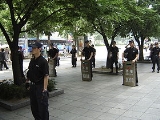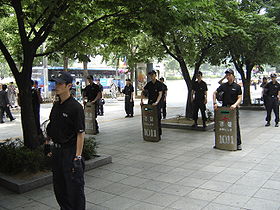
Seoul Metropolitan Police Agency
Encyclopedia
The Seoul Metropolitan Police Agency (SMPA) is the primary police
force for the South Korea
n capital city of Seoul
, and is one of 13 provincial police forces in the country, and is headquartered along with the National Police Headquarters in the city itself. While modern police agencies of Seoul can trace their history back to 1945 with the creation of a heavily American
influenced Korean police force, the modern-day Metropolitan Police Agency in Seoul came into being on August 1, 1991 and currently polices over 10 million inhabitants.
, as what was later termed a gas-pipe explosion took place in the Grand Hyatt Seoul Hotel, where he was planning to stay. In 1999 SMPA riot officers with tear gas and water cannons faced "several hundred" pro-unification marchers at Seoul National University
, however despite rocks being thrown at the police, there was no response and no serious clashes were reported.
The SMPA was given custody of two US Army soldiers charged with negligently killing two teenage girls in 2002. In 2006 the SMPA arrested a North Korea
n defector and ex bodyguard of Kim Jong-il
, as well as three others for trading fake aphrodisiacs in Seoul.
In 2007 SMPA was under scrutiny following the resignation of its police chief, Hong Young-ki, after an alleged revenge attack. Allegations were made that the SMPA overlooked the attack by its police chief on one of South Korea's richest men.

emblem of the SMPA which originated with its creation in 1945 was gradually phased out in favor of a smaller golden star by 1991, with similar golden, and then silver stars being replaced by American
-style chevrons.
The SMPA does, however, utilise certain technologies that are unique to its own force. With such a large population, the SMPA contracted Sepura
to outfit 5,000 TETRA radios and communication equipment to officers in July 2007. Sepura SRH3800 sGPS hand-held radios, and SRM3500 and SRG3500 in-vehicle radios were provided, along with new technology making its debut with the SMPA. The SMPA also utilise Road Speed Determination systems to collect real-time traffic information for Seoul's road network via GPS to be available for SMPA road units and members of the public.
Police
The police is a personification of the state designated to put in practice the enforced law, protect property and reduce civil disorder in civilian matters. Their powers include the legitimized use of force...
force for the South Korea
South Korea
The Republic of Korea , , is a sovereign state in East Asia, located on the southern portion of the Korean Peninsula. It is neighbored by the People's Republic of China to the west, Japan to the east, North Korea to the north, and the East China Sea and Republic of China to the south...
n capital city of Seoul
Seoul
Seoul , officially the Seoul Special City, is the capital and largest metropolis of South Korea. A megacity with a population of over 10 million, it is the largest city proper in the OECD developed world...
, and is one of 13 provincial police forces in the country, and is headquartered along with the National Police Headquarters in the city itself. While modern police agencies of Seoul can trace their history back to 1945 with the creation of a heavily American
United States
The United States of America is a federal constitutional republic comprising fifty states and a federal district...
influenced Korean police force, the modern-day Metropolitan Police Agency in Seoul came into being on August 1, 1991 and currently polices over 10 million inhabitants.
History
The first independent police force in Seoul was the US Army-led Kyunki-Do Police Department, which was brought into being on August 15, 1945 following the liberation of Korea from Japanese occupation. This was quickly followed up by the creation of a National Police Force on October 21, and a more dedicated Seoul Metropolitan Police Force on September 17, 1946. This organization underwent a series or reforms, including a renaming to the Metropolitan Police Bureau in 1948, the creation of the National Assembly Police Security Guards in 1951, the Seoul Mobile Police Corps ' creation in 1961, the Central Government Complex Police Security Guards in 1971, which were quickly joined by the Airport Police Security Guards in 1973 and the Olympic Security Guards in 1985. Together, these divisions became the present day Seoul Metropolitan Police Agency in 1991, with "1 Deputy Commissioner General, 7 departments, 2 directors, 17 divisions [and] 7 direct control squads."Events since 1993
In 1993, the SMPA was tasked with the investigation of a possible bomb threat to visiting American President Bill ClintonBill Clinton
William Jefferson "Bill" Clinton is an American politician who served as the 42nd President of the United States from 1993 to 2001. Inaugurated at age 46, he was the third-youngest president. He took office at the end of the Cold War, and was the first president of the baby boomer generation...
, as what was later termed a gas-pipe explosion took place in the Grand Hyatt Seoul Hotel, where he was planning to stay. In 1999 SMPA riot officers with tear gas and water cannons faced "several hundred" pro-unification marchers at Seoul National University
Seoul National University
Seoul National University , colloquially known in Korean as Seoul-dae , is a national research university in Seoul, Korea, ranked 24th in the world in publications in an analysis of data from the Science Citation Index, 7th in Asia and 42nd in the world by the 2011 QS World University Rankings...
, however despite rocks being thrown at the police, there was no response and no serious clashes were reported.
The SMPA was given custody of two US Army soldiers charged with negligently killing two teenage girls in 2002. In 2006 the SMPA arrested a North Korea
North Korea
The Democratic People’s Republic of Korea , , is a country in East Asia, occupying the northern half of the Korean Peninsula. Its capital and largest city is Pyongyang. The Korean Demilitarized Zone serves as the buffer zone between North Korea and South Korea...
n defector and ex bodyguard of Kim Jong-il
Kim Jong-il
Kim Jong-il, also written as Kim Jong Il, birth name Yuri Irsenovich Kim born 16 February 1941 or 16 February 1942 , is the Supreme Leader of the Democratic People's Republic of Korea...
, as well as three others for trading fake aphrodisiacs in Seoul.
In 2007 SMPA was under scrutiny following the resignation of its police chief, Hong Young-ki, after an alleged revenge attack. Allegations were made that the SMPA overlooked the attack by its police chief on one of South Korea's richest men.
Uniforms, organization, and ranks

| Rank in English | Abbreviation | Code |
|---|---|---|
| Commissioner General | Com. Gen. | CG |
| Chief Superintendent General | Ch. Supt. Gen | CSG |
| Senior Superintendent General | Sen. Supt. Gen | SCG |
| Superintendent General | Supt. Gen. | SG |
| Senior Superintendent | Sen. Supt. | SS |
| Superintendent | Supt. | S |
| Senior Inspector | Sen. Ins. | SI |
| Inspector | Ins. | I |
| Assistant Inspector | Ass. Ins. | AI |
| Senior Policeman | Sen. Pol. | SP |
| Policeman | Pol. | P |
Uniforms
The working uniforms of the SMPA consist of dark green or black trousers, light green or blue shirt and a black or white officer’s cap with emblems corresponding to the above ranks. The dress uniform, which has remained the same since 1945, consists of full black dress uniform and cap for male officers, and similar blue dress uniforms for female officers. The golden barnstarBarnstar
A barnstar is a decorative painted object or image, often in the shape of a five-pointed star but occasionally in a circular "wagon wheel" style, used to adorn a barn. They have no structural purpose, but may be considered lucky, akin to a horseshoe mounted over a doorway...
emblem of the SMPA which originated with its creation in 1945 was gradually phased out in favor of a smaller golden star by 1991, with similar golden, and then silver stars being replaced by American
United States
The United States of America is a federal constitutional republic comprising fifty states and a federal district...
-style chevrons.
Organization
The SMPA is organized under a commissioner, who works with the chiefs of a public relations division and an inspections relations division, as well as a deputy commissioner, to oversee the police force. The force is split into two sections, one which contains all the police officer corps, the Korean SWAT units, security guards and air units, and the other which contains intelligence, public affairs, security and traffic departments which in turn manage specialist police divisions of their own.Equipment
The SMPA operates much equipment which is standardized throughout the entire Korean National Police force. The metropolitan areas in particular user Automatic Vehicle Number Identification systems, however SMPA's computer dispatch systems, Automatic Vehicle Location Systems and Mobile Data Terminals are standard features across the country, as is policy of using specialist armed police rather than issuing firearms to each officer. SMPA also operates a significant percentage of the National Police Force's 4,891 police cars, 1,685 police pick- ups, 765 police trucks, 865 special-mission vehicles and 9,181 police motorcycles.The SMPA does, however, utilise certain technologies that are unique to its own force. With such a large population, the SMPA contracted Sepura
Sepura
Sepura plc is the only major network-independent TETRA terminal supplier. It designs, develops and supplies digital radios for the public safety market as well as Military, Transport and Utilities...
to outfit 5,000 TETRA radios and communication equipment to officers in July 2007. Sepura SRH3800 sGPS hand-held radios, and SRM3500 and SRG3500 in-vehicle radios were provided, along with new technology making its debut with the SMPA. The SMPA also utilise Road Speed Determination systems to collect real-time traffic information for Seoul's road network via GPS to be available for SMPA road units and members of the public.
Criticism
- SMPA Traffic Information Center requested to the TV journalists to report the university student-led candlelight rally as an "illegal rally" on June 12, 2011.

